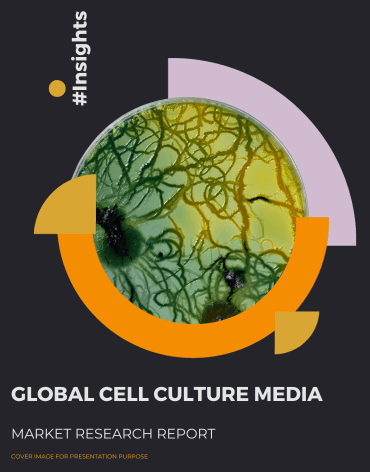Breaking Down the $4.63 Billion Cell Culture Media Market: What's Driving Growth?

- Nutrients: Cell culture media typically contain a mixture of amino acids, vitamins, minerals, and carbohydrates to provide the cells with the necessary nutrients for growth. These components may vary depending on the specific cell type and its requirements.
- Serum: Fetal bovine serum (FBS) or other animal-derived sera are often added to cell culture media to provide growth factors, hormones, and other essential factors. However, serum-free or defined media are used when researchers want to eliminate variability introduced by serum components.
- Buffers: Cell culture media are often buffered to maintain a stable pH, typically around 7.2 to 7.4. Common buffers include HEPES, bicarbonate, and phosphate buffers.
- Salts and Ions: Essential salts and ions such as sodium, potassium, calcium, and magnesium are included in cell culture media to maintain osmotic balance and support cellular functions.
- Growth Factors: Certain cell types may require specific growth factors or cytokines to promote proliferation and differentiation. These can include growth factors like EGF (epidermal growth factor), bFGF (basic fibroblast growth factor), and others.
- Antibiotics and Antimycotics: To prevent contamination with bacteria, fungi, and other microorganisms, antibiotics (e.g., penicillin and streptomycin) and antimycotics (e.g., amphotericin B) are often added to cell culture media.
- pH Indicator: Phenol red is a commonly used pH indicator in cell culture media, as it changes color with pH fluctuations and provides a visual indicator of the media's pH.
- Oxygen and Carbon Dioxide Levels: The concentration of oxygen and carbon dioxide in the incubator where cells are cultured must be carefully controlled to mimic physiological conditions.
- Sterility: Maintaining sterility is critical in cell culture. Media and equipment must be sterilized, and sterile techniques must be followed to prevent contamination.
- Customization: Depending on the specific cell type, researchers may need to customize the media formulation with additional components or supplements.
- Dulbecco's Modified Eagle Medium (DMEM): A versatile and widely used medium suitable for many cell types.
- RPMI 1640: Often used for the culture of mammalian cells, particularly immune cells like lymphocytes.
- Minimum Essential Medium (MEM): Another commonly used medium with various formulations, including Eagle's MEM and MEM Alpha.
- Iscove's Modified Dulbecco's Medium (IMDM): Designed for the growth of hematopoietic cells and other specialized cell types.
- F-12 Nutrient Mixture: Used for the culture of epithelial and other adherent cell types.
1 . The Global Cell Culture Media Market
- The global Cell Culture Media market was valued at $2.445 billion in 2022 and is anticipated to reach $4.63 billion by 2029, witnessing a CAGR of 9.48% during the forecast period 2023-2029.
- The North American market for Cell Culture Media is estimated to increase from $0.893 billion in 2023 to $1.41 billion by 2029, at a CAGR of 7.9% from 2023 through 2029.
- The Asia-Pacific market for Cell Culture Media is estimated to increase from $0.873 billion in 2023 to $1.65 billion by 2029, at a CAGR of 11.19% from 2023 through 2029.
- Classic Medium:Classic cell culture medium typically refers to traditional media formulations that have been used for many years in cell culture. These media often contain serum, such as fetal bovine serum (FBS), which provides a wide range of nutrients, growth factors, and hormones that support the growth and maintenance of various cell types. Classic media formulations like Dulbecco's Modified Eagle Medium (DMEM), RPMI 1640, Minimum Essential Medium (MEM), and others fall into this category.
These media are suitable for a broad range of cell types and are often used in routine cell culture applications. However, the use of serum in classic media can introduce variability due to batch-to-batch differences in serum composition. Therefore, researchers may opt for serum-free or defined media in certain cases. - Serum-Free Medium:Serum-free medium, as the name suggests, does not contain serum or any animal-derived components. Instead, it is formulated with defined components, including specific growth factors, hormones, and nutrients. Serum-free media are designed to provide greater control over the cell culture environment, reduce variability, and minimize the risk of introducing pathogens from animal-derived sera.
Serum-free media are commonly used in applications where precise control over cell growth and behavior is critical, such as in the production of biopharmaceuticals, vaccine development, and certain stem cell culture protocols. These media are also useful when researchers want to study the effects of specific factors on cell behavior without interference from unknown serum components. - Stem Cell Culture Medium:A stem cell culture medium is specifically designed for the growth and maintenance of stem cells. Stem cells are unique because they can self-renew and differentiate into various cell types. To support these characteristics, stem cell culture media are tailored to provide the necessary signaling molecules and growth factors to keep stem cells in an undifferentiated state or guide them toward differentiation into specific cell lineages.
Stem cell culture media can vary significantly depending on the type of stem cells being cultured (e.g., embryonic stem cells, induced pluripotent stem cells, adult stem cells) and the desired outcomes (e.g., expansion, differentiation). These media formulations often include factors like leukemia inhibitory factor (LIF) for maintaining pluripotency in embryonic stem cells or specific lineage-inducing factors for differentiation.
3 . Cell Culture Media Applications
- Vaccine Production: Cell culture media are crucial in the production of vaccines. Many vaccines are produced by growing the target virus or bacterium in cell cultures. The virus or bacterium is propagated in cells, and the cell culture media provides the necessary nutrients and environment for their growth.
- Vaccine Research and Optimization: Research institutes involved in vaccine development use cell culture media to culture cells for various purposes, such as studying the biology of pathogens, screening potential vaccine candidates, and optimizing vaccine production processes.
- Safety and Efficacy Testing: Before vaccines are approved for use, they undergo extensive safety and efficacy testing. Cell culture media are used in these tests to culture cells for vaccine testing, including assessing their effectiveness in preventing disease and ensuring they do not cause harm.
- Drug Discovery: Pharmaceutical research institutes use cell culture media to culture cells for drug discovery and development. This involves screening compounds for potential therapeutic effects on cells, studying cell signaling pathways, and identifying potential drug candidates.
- Biopharmaceutical Production: Cell culture media are critical in the production of biopharmaceuticals, which include protein-based drugs like monoclonal antibodies and recombinant proteins. Cells are cultured in bioreactors using specialized media to produce these drugs at a large scale.
- Toxicology and Safety Testing: Researchers use cell culture media to culture cells for toxicology studies. This helps assess the safety of potential drug candidates and understand their effects on cells, tissues, and organs.
- Stem Cell Research: Stem cell culture media are essential in pharmaceutical research involving stem cells. This includes studying the differentiation of stem cells into specific cell types for regenerative medicine and tissue engineering applications.
4 . Leading Companies
- Thermo Fisher Scientific:
- Thermo Fisher Scientific is a global leader in providing scientific research products, services, and technologies. They offer a wide range of laboratory equipment, reagents, consumables, and analytical instruments used in life sciences, genomics, proteomics, pharmaceuticals, and diagnostics.
- Thermo Fisher is known for its contributions to various areas, including molecular biology, genetics, analytical chemistry, and healthcare diagnostics.
- Merck (MilliporeSigma):
- Merck, operating as MilliporeSigma in the United States and Canada, is a multinational pharmaceutical, chemical, and life sciences company. They provide a broad range of products and services, including chemicals, reagents, laboratory supplies, and solutions for life science research and pharmaceutical manufacturing.
- MilliporeSigma is recognized for its expertise in cell culture, filtration, and bioprocessing technologies.
- Corning Incorporated:
- Corning is a renowned manufacturer of specialty glass and ceramics. They are known for their laboratory glassware and cell culture products, including cell culture vessels, surface treatments, and bioprocess solutions.
- Corning's products are widely used in cell culture, drug discovery, and biomanufacturing applications.
- Cytiva:
- Cytiva, formerly known as GE Healthcare Life Sciences, specializes in providing products and services for bioprocessing, cell therapy, and biomanufacturing. They offer solutions for process development, purification, and analytics in the biopharmaceutical industry.
- Cytiva is recognized for its chromatography columns, filtration technologies, and single-use bioprocessing systems.
- Lonza Group:
- Lonza is a global provider of integrated solutions and services for the pharmaceutical, biotech, and specialty ingredient markets. They offer a range of products and services related to cell therapy, bioprocessing, and pharmaceutical manufacturing.
- Lonza is known for its expertise in cell and gene therapy manufacturing, as well as its biomanufacturing capabilities.
- Fujifilm Corporation:
- Fujifilm is a multinational corporation with a wide range of business interests, including imaging and information technologies, healthcare, and life sciences. In the life sciences sector, Fujifilm offers products and services related to cell culture and regenerative medicine.
- Fujifilm has made significant advancements in the development of regenerative medicine and cell therapy products.






